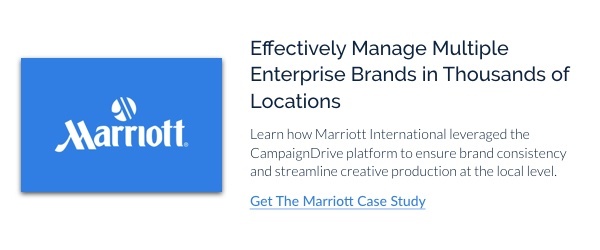Before a customer purchases a product or service, they are exposed to a variety of marketing "touch points" designed to bolster brand awareness and boost engagement. However, how do multi-location brands measure the impact of their local marketing and more importantly, how do they attribute certain brand awareness activities to particular sales or conversions?
While major multi-location brands like Marriott have all kinds of tools designed to help them figure out what marketing programs really work, it's still incredibly challenging to attribute results to marketing activities across a geographically distributed network of franchisees and partners.
In this article, you'll learn why marketing attribution matters for multi-location brands and why attribution is so challenging even for the most renowned brands. We'll also share five attribution techniques brand managers can use to uncover data-driven insights on the effectiveness of their local marketing.
Three Reasons Distributed Brands Struggle with Attribution
Measuring the effectiveness of your marketing can be done in a variety of ways including surveys, focus groups, web search analysis, point-of-sales, social media shares, and more. However, many distributed organizations face a few distinct hurdles on their path towards proper marketing attribution:
1. Attribution Across Dozens of Channels is Complex
While digital channels promise easier measurement through real-time analytics, reporting and return-on-advertising spend (ROAS) metrics, they often under-deliver on that promise because aggregating, correlating and rationalizing metrics across dozens of channels is still incredibly complex. Data indicates that print marketing and other offline campaigns are highly-effective as well. However, heavy inclusion of offline sources in the local marketing mix can really complicate attribution even further. Today's brand managers must absolutely monitor and analyze the effectiveness of all marketing channels, both online and offline.
2. Attribution Models Vary
Unfortunately, there isn't an industry-wide standard for tracking. For instance, when advertising through a third-party resource, many advertisers follow different attribution models. Are they crediting an advertisement's effectiveness through impressions or clicks? With so many competing attribution models, it's difficult to measure and organize the effectiveness of a particular ad, especially across multiple advertising networks.
3. Consumers Don't Convert Because of a Single Marketing Activity
How many touch points are required before a consumer converts? In the case of an impulse purchase, you might think only one interaction is needed. However, impulse purchases have to be supported with brand recognition and so the cases where only a single marketing touch leads a customer to buy are incredibly rare.
Additionally, when the cost of a particular product or service is high, consumers will need a little more convincing. Most consumers typically require multiple marketing touch points before converting. As such, when trying to attribute a conversion to a single touch point, brand managers run the risk of exaggerating the effectiveness of any particular marketing activity.
5 Techniques for Measuring Local Marketing Effectiveness
1. Measure Frequently to Track Changes Over Time
Multi-location brands may have some success using narrower data sets to understand how awareness-building marketing activities impacted purchase decisions within a specified time frame. If you track all sales that occurred in a given quarter and look at the national marketing activities that occurred within the same time frame, you can better understand how to attribute credit to various channels and activities. Headquarters marketers can gain insight into campaign success by performing time-based attribution analysis on a regular basis, such as monthly, quarterly or annually.
2. Track Location-Specific Activities
There’s also some better visibility into attribution paths for marketers who narrow down sales to particular locations and related attribution paths. This approach isn’t always comprehensive. It’s unlikely that you can attribute percentages of sale primarily to a single attribution path, except in rare instances. You can try to improve sales correlation with tactics such as using campaign-specific coupons that are captured with point-of-sale data, but it can't be comprehensive.
While narrowing the geographic scope of attribution analysis does not always capture the full picture either, it can reveal insight into how locations and demographics affect your results. This kind of analysis can provide insight into the types of awareness activities that are valuable in certain markets, such as the success of banner ads and localized landing pages among urban consumers.
3. Use Digital Behavior
While multi-location digital attribution is difficult, using digital tools to measure search volume for your brand, product or services across your locations can provide value over time if brands establish a baseline using a tool such as Google Trends or a digitally-integrated lead tracking system within your customer relationship management (CRM) tools.
When combined with sales data, creating a baseline for digital tracking and measuring changes over time can show whether brand awareness activities in a given market are leading to changes in purchase and search behavior on your owned digital channels. This method of tracking can be particularly valuable for brands with higher-priced products and a longer sales cycle, such as dealerships.
4. Use Point-of-Sale Data
Brand managers at multi-location brands can glean some attribution insights via locational point-of-sale (POS) data, though it is important to recognize the limits to POS data and the dangers of single-point attribution. Bad analytics can be more dangerous than no analytics, especially when inaccurate information is used to make decisions about next quarter's marketing mix.
Taking representative samples of location-based performance can offer some value, especially when a baseline is established. Point-of-sale data may be valuable for understanding the response rate or sales lift following a major brand awareness initiative in a given location. This method of analysis is particularly valuable for marketing experiments, such as the introduction of a certain type of paid search campaign within a specific market to measure lift in sales against similar locations that were not using those brand awareness activities.
Once a baseline is established, then you should ensure that all activities (except those being tested) remain constant. This includes minor changes like changing your target audience or adding a new media type. With a baseline established, marketing activities held constant, and a fully integrated attribution system in place, test campaigns can now be run to provide insight into what marketing programs to run in the future. When multiple media types are to be combined into a single campaign, the attribution system should understand how to allocate conversions to the media types both independently and together.
If new marketing campaigns are to be continually tested, marketers need to clearly identify what the baseline is before proceeding, noting that there may now be a “new” baseline. If the search campaign above is terminated and replaced with something different, then the new baseline would remain the same. If, however, a new campaign is layered upon it, then the new baseline must be established.
5. Implement Technology to Understand Your Local Marketing
Another common challenge for attribution in the multi-location model is a lack of oversight into local marketer activities. While some brands who maintain strict control over what franchisees can do locally understand exactly what’s going out at the local level, many others don’t. The distance between local marketers and brand headquarters teams isn’t just the reason there end up being so many non-compliant brands, it’s also a factor that makes attribution incredibly difficult.
Technologies like Local Marketing Automation (LMA) software allow marketers to understand which assets are being localized and released into the local markets, including offline advertising via print and collateral templates and integrations with marketing platforms.
When brand marketers use LMA reporting features to understand how affiliates are approaching their local media mix and how those choices are impacting sales, there’s a possibility to connect multi-touch and multi-channel marketing activities to location-based sales results. LMA can also be particularly valuable for brand teams who are running multi-location marketing experiments, as a source for understanding whether local activity could be swaying the accuracy of results.
Effective Local Marketing Can Be Easy
Are you ready to track and improve the effectiveness of your local marketing activity?
Measuring and attributing local marketing results is tough. For multi-location brands, the multi-factor indicators needed to understand how offline and online marketing activities contribute to overall brand awareness and sales aren't easy to put in place. While it’s important to avoid placing too much weight on the results of attribution analysis, creating a baseline and measuring changes via multiple sources can reveal what you need to take your local marketing results to the next level.








